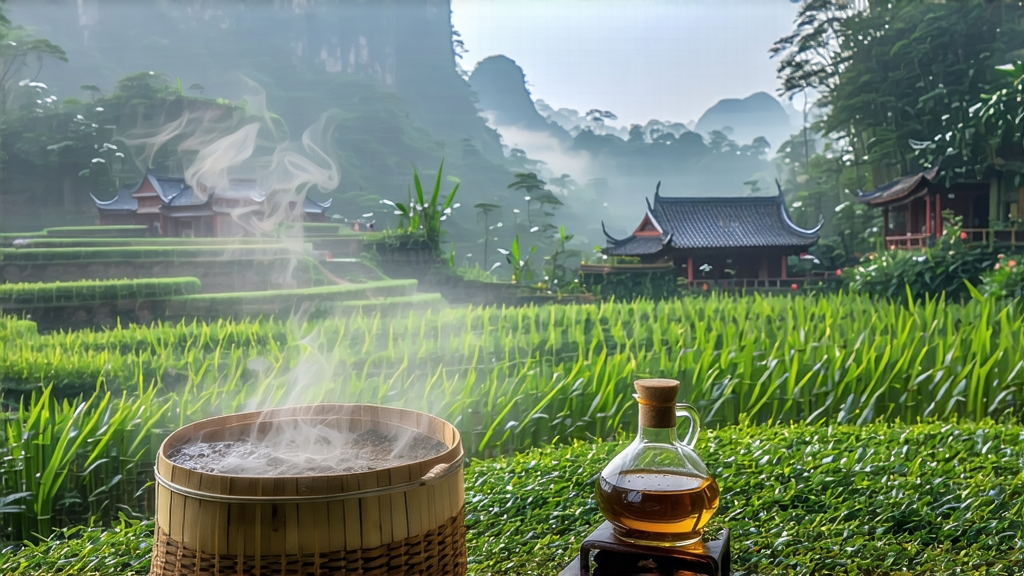
Tucked away in the humid, karst-pitted mountains of southern China’s Guangxi Zhuang Autonomous Region, Liu Bao tea has spent four centuries quietly perfecting the art of microbial alchemy. To most outsiders “dark tea” begins and ends with Yunnan’s Pu-erh, yet Liu Bao is the older, subtler sibling—fermented, pressed, and then left to breathe inside giant bamboo husks until its leaves turn the color of midnight mahogany and its liquor glows like burnt topaz. This essay invites the global tea traveler to discover Liu Bao’s history, craftsmanship, and the almost ritualistic way it is brewed, tasted, and cherished.
-
A Leaf Born from Migration and Military Roads
Liu Bao village—today a forty-minute drive from Wuzhou city—sits on the trade artery that once connected the Pearl River Delta to the ancient thoroughfares of Guangxi and Yunnan. During the Ming dynasty (1368-1644) imperial troops marching against southwestern rebellions demanded a tea that would neither spoil on humid marches nor overstimulate weary soldiers. Local growers responded by fully firing the leaves, then packing them into tightly woven bamboo baskets whose breathable walls allowed slow, steady post-fermentation. By the Qing era the same baskets were being floated down the Xun River to Guangzhou’s Thirteen Factories, where foreign merchants bought “basket tea” as ballast for ships bound for Southeast Asia. In Malaya and Singapore the laboring coolies discovered that a cup of Liu Bao settled the stomach after a greasy tin-mine breakfast; the British planters, meanwhile, noticed their workers never suffered dysentery when they drank it. Thus Liu Bao slipped into the steamy diaspora of Cantonese and Hakka migrants, becoming an unheralded daily medicine long before the West coined the term “probiotic.” -
The Terroir of Humid Karst
Unlike the mist-cooled terraces of Yunnan, Liu Bao’s gardens lie below 500 m amid limestone pinnacles that trap moisture and reflect heat. The indigenous camellia sinensis var. sinensis bushes, many over eighty years old, send roots deep into fissures rich in calcium and magnesium. The result is a leaf unusually high in pectins and polyphenols—ideal substrates for the yeasts and actinomycetes that will later sculpt flavor. Spring picking begins just before Qingming festival when two leaves and a bud still wear a pale down; farmers call this stage “sparrow’s tongue” because the tiny tips curve like bird bills. After plucking, the leaves are carried downhill in wicker backpacks lined with banana leaves to keep them from oxidizing prematurely in the mountain heat. -
Crafting the Darkness: Kill-Green, Rolling, Piling, and Basket Aging
The transformation from verdant leaf to midnight brick unfolds in four acts:
Act I – Kill-Green (Sha Qing)
Within two hours of harvest the leaves are tumble-roasted in iron woks heated to 200 °C for three to four minutes. The goal is not the fragrant arrest common in green tea but a deeper de-enzyming that leaves the cellular structure relaxed yet intact, ready for microbial invasion.
Act II – Rolling (Rou Nian)
While still warm, the leaves are rolled under mechanical drums for twenty minutes; the moderate pressure cracks the cuticle just enough to release sticky juices that will later glue the leaves together when pressed.
Act III – Wet Piling (Wo Dui)
Here Liu Bao diverges from Pu-erh. Instead of Yunnan’s dry-pile technique, Liu Bao uses a shorter, hotter, mofer pile. The leaves are heaped 70 cm high on bamboo mats, sprayed with mineral-rich mountain water, and covered with jute sacks. Internal temperature is monitored twice daily; when it hits 55 °C the pile is turned to aerate and re-moisten. After 10–15 days the leaf mass has halved in volume and turned the color of rusted iron. Microbiologists have isolated Eurotium cristatum—the same “golden flower” prized in Hunan’s Fu brick—alongside thermophilic Aspergilli that produce a unique coumarin-like aroma locals liken to “old betel-nut.”
Act IV – Sun-Drying and Basket Pressing
The fermented leaf is spread on bamboo racks for three days of gentle sun, bringing moisture down to 12 %. It is then stuffed by hand into cylindrical bamboo baskets lined with wild banana leaf. A team of three men t